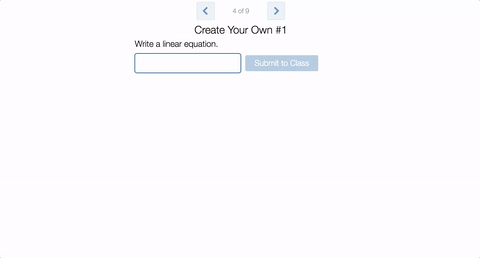“How do you use the teacher dashboard in class?”
We asked the Desmos Fellows this week to pick an upcoming or completed
activity and tell how they would use the teacher dashboard during the
activity. Responses fell on a spectrum, with many of the fellows describing
how they use the dashboard during the launch, explore, or summarize part of a
lesson. We also got ideas for using the dashboard to analyze student work and
to extend an activity.
Launch
-
Dave Sabol recently used
teacher pacing in
Charge
for screens 1-4. This encouraged participation from all students and allowed
Dave to select students to share their thinking.
-
Scott Miller also used teacher
pacing for the first three slides of an activity to enable an informal
introduction to a task that would later be completed algebraically. This
allowed students to ask clarifying questions about the context before they
got to more challenging parts.
-
Jenn Vadnais used teacher pacing
at the beginning of an
activity
to model the use of and give students practice with a tool that would later
be useful in solving fraction challenges.
-
Paul Jorgens recently did an
activity
with his class on transformations that started with a “which one doesn’t
belong” prompt where the students had to pick a cow. He used teacher pacing
on screen 1 to give students a chance to argue for their selection. The
histogram and responses for this screen were both valuable, showing that
each cow had been chosen by at least one student and allowing strategic
selection of students to share justifications.
Explore
-
Bob Lochel found that adding a
couple of “yes/no” multiple choices questions to an activity
gave a natural spot to pause for discussion and sharing out.
-
Anna Scholl has been
intentional about designing activities with natural stopping points for
discussion. She’s found that creating 2-3 slides for students to work and
think through followed by pause makes for a nice balance. She’s also found
that a card sort with extra answers that are wrong, or multiple correct
answers based on unknown information helps generate discussion in her
class.
-
Adam Poetzel designed an
activity
for students to represent multiplication problems as arrays that is intended
to be entirely teacher paced. For screens 3-5 Adam lists a series of
questions in the teacher tips that teachers can pose to probe and extend
students thinking. On Screen 5, when teachers ask questions such as
“Make a parade that has 24 faces, and write the matching math
sentence”, there may be several possible parades made by students.
When ready, the teacher can pause the class and display several different
student screens. The class can decide if the parade does have the correct
number of faces and if the math sentence is correct.
-
Nolan Doyle shared two
activities with us this week that he used for an informal exploration of
domain and range
as well as
increasing and decreasing intervals
of quadratics. Nolan used teacher pacing after the initial exploration to
build on student thinking as he introduced interval notation. He shared that
“it worked really well to allow students to explore the concepts through
Desmos and use those exact graphs for their notes as we came together as a
class to formalize their thoughts and discoveries.”
-
Nick Corley uses a tablet
while circulating the class to see if any students are struggling and to
guide them in the correct direction. He also projects the dashboard during a
card sort screen so that students can identify when they are correct.
Summarize
-
Tony Riehl also uses a tablet to
monitor student progress as he walks around the room. This helps him check
in with students as well as pause and pace for class discussions as needed.
Students in Tony’s class work in groups and provide each other support
throughout the activity. Tony further supports student learning by using
pause and pace at the end of the activity to help summarize the activity and
ensure that students leave with the same information.
-
Sarah Blick Vandivort paused her
class after slide 12 of
Systems of Two Linear Equations
to drive home the idea that the point of intersection is the solution and it
makes both equations true.
Extension
-
Paul Jorgens designed
Translations and Reflections
so that students that finished early had a chance to created their own
challenge. He chose a few of the student created challenges at the end of
the activity and had students discuss in groups how they might solve the
challenge from their peers.
Analyze Student Work
-
Teachers in
Patty Stephen’s district
used Desmos for an assessment, and used the teacher dashboard to look at
student responses and analyze student work together. Patty notes that the
ability to share a dashboard with another teacher in her district would have
been helpful to the collaboration process.
How have you used the Teacher Dashboard to monitor student learning and
increase classroom conversation? Let us know on Twitter @desmos.

